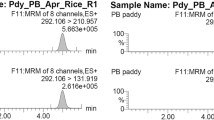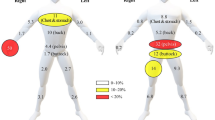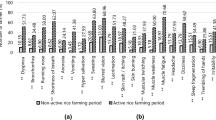Abstract
An outbreak of typhoid fever in rural Malawi triggered an investigation by the Malawi Ministry of Health and the Centers for Disease Control and Prevention in July 2009. During the investigation, villagers were directly consuming washed, donated, pesticide-treated wheat seed meant for planting. The objective of this study was to evaluate the potential for pesticide exposure and health risk in the outbreak community. A sample of unwashed (1430 g) and washed (759 g) wheat seed donated for planting, but which would have been directly consumed, was tested for 365 pesticides. Results were compared with each other (percentage change), the US Environmental Protection Agency's (EPA) health guidance values and estimated daily exposures were compared with their Reference dose (RfD). Unwashed and washed seed samples contained, respectively: carboxin, 244 and 57 p.p.m.; pirimiphos methyl, 8.18 and 8.56 p.p.m.; total permethrin, 3.62 and 3.27 p.p.m.; and carbaryl, 0.057 and 0.025 p.p.m.. Percentage change calculations (unwashed to washed) were as follows: carboxin, −76.6%; pirimiphos methyl, +4.6%; total permethrin, −9.7%; and carbaryl −56.1%. Only carboxin and total permethrin concentration among washed seed samples exceeded US EPA health guidance values (285 × and seven times, respectively). Adult estimated exposure scenarios (1 kg seed) exceeded the RfD for carboxin (8 × ) and pirimiphos methyl (12 × ). Adult villagers weighing 70 kg would have to consume 0.123, 0.082, 1.06, and 280 kg of washed seed daily to exceed the RfD for carboxin, pirimiphos methyl, permethrins, and carbaryl, respectively. Carboxin, pirimiphos methyl, permethrins, and carbaryl were detected in both unwashed and washed samples of seed. Carboxin, total permethrin, and carbaryl concentration were partially reduced by washing. Health risks from chronic exposure to carboxin and pirimiphos methyl in these amounts are unclear. The extent of this practice among food insecure communities receiving relief seeds and resultant health impact needs further study.
This is a preview of subscription content, access via your institution
Access options
Subscribe to this journal
Receive 6 print issues and online access
$259.00 per year
only $43.17 per issue
Buy this article
- Purchase on Springer Link
- Instant access to full article PDF
Prices may be subject to local taxes which are calculated during checkout

Similar content being viewed by others
References
Gurley ES, Rahman M, Hossain MJ, Nahar N, Faiz A, Islam N et al. Fatal outbreak from consuming Xanthium strumarium seedlings during time of food scarcity in northeastern Bangladesh. PLoS One 2010: 5 (3): e9756.
Getahun H, Mekonnen A, TekleHaimanot R, Lambein F. Epidemic of neurolathyrism in Ethiopia. Lancet 1999: 354 (9175): 306–307.
Haque A, Hossain M, Wouters G, Lambein F. Epidemiological study of lathyrism in northwestern districts of Bangladesh. Neuroepidemiology 1996: 15 (2): 83–91.
Bonmarin I, Nunga M, Perea WA. Konzo outbreak, in the south-west of the Democratic Republic of congo, 1996. J Trop Pediatr 2002: 48 (4): 234–238.
Bakir F, Damluji SF, Amin-Zaki L, Murtadha M, Khalidi A, Al-Rawi NY et al. Methylmercury poisoning in Iraq: an interuniversity report. Science 1973: 181: 230–241.
Ordóñez JV, Carrillo JA, Miranda M, Gale JL. Epidemiologic study of a disease believed to be encephalitis in the region of the highlands of Guatemala. Bol Oficina Sanit Panam 1966: 60 (6): 510–519.
Lutterloh EC, Likaka A, Sejvar J, Naiene J, Mintz E, Manda M et al. Typhoid Fever with Neurologic Features — Malawi-Mozambique Border, 2009. Epidemic Intelligence Service Conference: Atlanta, GA, 2010.
Osuntokun BO, Bademosi O, Ogunremi K, Wright SG. Neuropsychiatric manifestations of typhoid fever in 959 patients. Arch Neurol 1972: 27: 7–13.
Khosla SN, Srivastava SC, Gupta S. Neuro-psychiatric manifestations of typhoid. J Trop Med Hyg 1977: 80 (5): 95–98.
US Food and Drug Administration. Pesticide Analytical Manual (PAM), Vol. I, 3rd edn, Revised October 1999, published by the US Food and Drug Administration, 1994.
United States Environmental Protection Agency. Glossary of Terms. Available at: http://www.epa.gov/economics/children/basic_info/glossary.htmr (Accessed on: 3 November 2009).
United States Environmental Protection Agency. Reference Dose (RfD): Description and Use in Health Risk Assessments. Available at: http://www.epa.gov/iris/rfd.htm1.1 (Accessed on: 3 November 2009).
Code of Federal Regulations (CFR): Main Page. Available at: http://www.gpoaccess.gov/cfr/ (Accessed on: 5 January 2011).
Hollingworth RM. Chapter 57 — inhibitors and uncouplers of mitochondrial oxidative phosphorylation. Krieger R (ed). Handbook of Pesticide Toxicology, 2nd edn. San Diego, CA, 2001.
EPA. Reregistration Eligibility Decision for Carboxin. Available at: http://www.epa.gov/oppsrrd1/REDs/0012red_carboxin.pdf (Accessed on: 2 November 2009).
Lotti M. Clinical toxicology of anticholinesterase agents in humans. In: Krieger R (ed). Handbook of Pesticide Toxicology, 2nd edn. San Diego: CA, 2001.
Kaplan JG, Kessler J, Rosenberg N, Pack D, Schaumberg H. Sensory neuropathy associated with Dursban (chlorpyrifos) exposure. Neurology 1993: 43: 2193–2196.
Pilkington A, Jamal GA, Gilham R, Hansen S, Buchanan D, Kidd M, et al. Epidemiological study of the relationships between exposure to organophosphate pesticides and indices of chronic peripheral neuropathy, and neurophysiological abnormalities in Sheep Farmers and Dippers. Phase 3. Clinical neurological, neurophysiological and neuropsychological study. Occupational Medicine Environment. Institute of Occupational Medicine: Edinburgh, 1999.
Morgan JP, Penovich P. Jamaica ginger paralysis: 47-year follow up. Arch Neurol 1978: 35: 530–532.
Inoue N, Fujishiro K, Mori K, Matsuoka M. Triorthocresyl phosphate poisoning--a review of human cases. J UOEH 1988: 10 (4): 433–442.
United States Environmental Protection Agency. Integrated Risk Information System. Pirimiphos-methyl (CASRN 29232-93-7). Available at: http://www.epa.gov/IRIS/subst/0257.htm (Accessed on: 10 December 2011).
Holland MG. Chapter 110 — insecticides: organic chlorines, pyrethrins/pyrethroids, and DEET. In: Goldfrank LG, et al (eds). Goldfrank's Toxicologic Emegencies, 8th edn. New York: NY, 2006.
United States Environmental Protection Agency. Integrated Risk Information System, Permethrin; CASRN 52645-53-1. Available at: http://www.epa.gov/IRIS/subst/0185.htm (Accessed on: 31 January 2012).
Fisher SW, Metcalf RL. Production of delayed ataxia by carbamic acid esters. Pestic Biochem Physiol 1983: 19: 243–253.
Wills JH, Jameson E, Coulston F. Effects of oral doses of carbaryl on man. Clin Toxicol 1968: 1: 265–271.
Branch RA, Jacqz E. Subacute neurotoxicity following long-term exposure to carbaryl. Am J Med 1986a: 80: 741–745.
Ecobichon DJ, Joy RM. Carbamic acid ester pesticides. In: Pesticides and Neurological Diseases. CRC Press: Boca Raton FL, 1982.
Acknowledgements
This study was supported from the CDC.
Disclaimer
The findings and conclusions in this article are those of the author(s) and do not necessarily represent the views of the Centers for Disease Control and Prevention or Agency for Toxic Substances and Disease Registry. The seed pictured in the photo is not the seed tested by FDA Laboratories.
Author information
Authors and Affiliations
Corresponding author
Ethics declarations
Competing interests
The authors declare no conflict of interest.
Rights and permissions
About this article
Cite this article
Schier, J., Sejvar, J., Lutterloh, E. et al. Consumption of pesticide-treated wheat seed by a rural population in Malawi. J Expo Sci Environ Epidemiol 22, 569–573 (2012). https://doi.org/10.1038/jes.2012.47
Received:
Accepted:
Published:
Issue Date:
DOI: https://doi.org/10.1038/jes.2012.47



